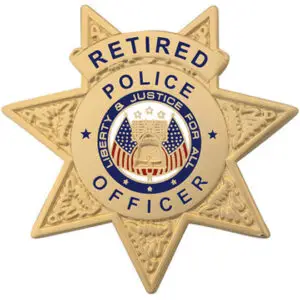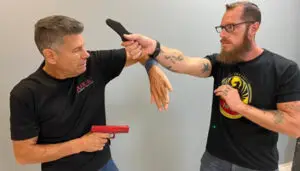“Same old, same old” is a pretty common saying to express boring repetition. It can mean that what we’re doing today is the same as yesterday. Seems like we’re always looking for something new and different. Firearms instructors have witnessed this phenomenon for decades. Look at shooters and instructors of recent years and you’ll see every nicky-neat item of dubious benefit hanging on a firearm, a duty belt, or the body – brass catchers, magazine baseplate knives, bottle openers, pistol bayonets, gun-in-gun stocks, spring-loaded holsters, red lights, green lights, flashing lights, revolving lights…Sheeeesh. Why are we looking for tricks to make us better? And it’s not limited to the non-law enforcement type either. We occasionally play the same game – extremely light triggers, cut-away or altered trigger guards, flat triggers, curved triggers, bucket-lipped magazine wells, deactivated holster retention, tape, glue, melted grips, etc. You get the picture. Maybe some of these make us better performers on the range but gunfights rarely occur on the range, under range rules, using range targets with the contest being decided with range scoring. They usually start within arm’s reach, are finished in three-five seconds, with no whistle, bell, turning target or crossed-eye instructor to initiate the disagreement. Not much time to deploy a picatinny-mounted “Pocket Fisherman.” Ok, how does this fit into a training narrative? Many agencies still rely on a qualification course/score instead of leaning into gunfighting. Qualification courses and other courses which emphasize speed under stress and marksmanship, without decision making skills may actually enhance liability.
Handgun fights haven’t changed very much in the past 150-years. Someone is trying to shoot someone else at relatively close range without getting shot themselves. Sound familiar? Equipment has certainly changed but that means little to a determined man. Officers are dying somewhat regularly at the hands of criminals who are less-trained and less-equipped but more determined.
Statistically speaking, we are not dying because we don’t draw fast enough, reload fast enough, or pull the trigger quick enough. We are dying because we fail to recognize active threats soon enough, and when we do, we don’t respond effectively. Then why do we worry ourselves with tacti-cool range drills but somehow miss the fight-winning methods?
The instructor’s answer to improving the chances of winning a life-or-death gun battle is the ingraining of appropriate fight-winning methods, not just shooting skills. That seems like a basic idea but it’s easier said than done. Consider the three training R’s that were a result of Popow v. City of Margate (476 F. Supp. 1237 United States District Court). Deadly force training must be; 1) Recent – conducted often enough for learning to take place and using materials timely the topic; 2) Realistic – conducted in an environment similar to an officer’s assignment; 3) Relevant – training must match officers’ assignment (ex. clothing/gear similar to assignment instead of special training cloths)
Let’s review some basic tips for creating drills to support your message:
- must use street-level equipment as issued for use in assignment (no special clothing, gear)
- must be relevant to assigned position such as detectives, K9, SRO, uniform patrol, etc
- must press the realistic, street-level, fast, gunfight (not qualification-style shooting)
- must allow student to problem solve (quit holding students hand and let them find the solution)
Drills can be:
- Static – “square range”-type that tests proficiency
- Dynamic – compressed time frames requiring some form of movement, cover, multiple targets, etc. that is performed at the student’s speed, sometime with a partner.
- Interactive – may not involve “live” firearms but requires strong decision making and tactics with various gear, levels of force, and professional language. Our goal is not only the “how” of deadly force but the “when” and “why”.
Consider partially exposed threats, varying lighting conditions, unknown distances to include very close, incorporate less-lethal options occasionally, require some movement and appropriate, legally defensible language/commands.
Non-shoot targets are a great way to introduce critical decision making under stress and will require an additional set of communications. Also, have the student fully load his firearms instead of starting with a partially loaded magazine. Somehow knowing you’re about to enter a gunfight and intentionally down-loading mags is a poor choice for teaching a winning mindset. Let the student problem-solve.
All methods and range commands must have a purpose, be safe, and realistic to a student’s work assignment with clear goals for success. Remember to “explain”, then “demonstrate” prior to “execution” when possible. Finally, document every skill included in each drill and performance expectations of each student. And your performance expectations? Lift them higher starting right now. The “same old, same old” is ok for your breakfast menu but not your use-of-force training. Avoid the “same old”, and find an IALEFI training experience, such as the Annual Training Conference, Regional Training Conference, Master Instructor Development Program or other local event, to maximize your training practices and become an instructor who changes lives.



